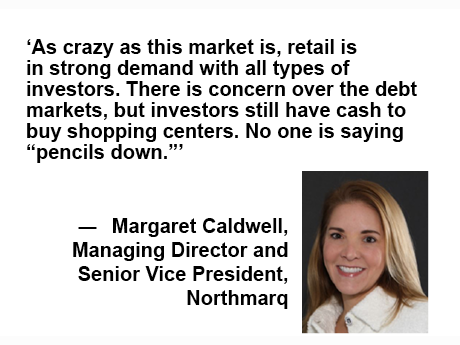Margaret Caldwell, managing director and senior vice president at Northmarq in Atlanta, thinks this is a great time to be a retail owner. The only problem? Sellers do too.
“The biggest challenge is the small supply of retail in this market,” she says. “Sellers are very hesitant to sell, even though the ones who are selling are experiencing great results and achieving their pricing.”
Caldwell notes that in the Southeast there has been a slight change in pricing of around 50 basis points over the past year or so. However, shopping centers — particularly in Atlanta, Charlotte, Raleigh, Charleston, Greenville, and most of Florida and Texas — are still trading at historically low cap rates. Occupancy is also at a historic high in many areas, she adds, with strong leasing and rent growth.
“It’s really hard to understand why these sellers are reluctant to sell, with the exception of those who will require a 1031 exchange or a replacement asset for cash flow,” Caldwell continues. “Those situations are kind of a catch-22 since properties are so hard to come by nowadays.”
The Recipe for This Retail Market
Some of the fundamentals that created this strong Southeastern retail market were put into place before the pandemic. After all, much of the country was still over-retailed in 2019, though no one could have predicted the shakeup that was to come.
“Some retail was taken offline prior to COVID,” Caldwell says. “This was mostly Class B and C malls. They were repositioned with less retail, which helped the market become stronger.”
The pandemic also acted as a Darwinian force of sorts. Though establishments everywhere were shuttered for varying periods of time, most retail experts agree that this act “tested” the strength of many retailers. Those who survived were even stronger for it. Those who didn’t freed up space for the concepts that hit the ground running once restrictions were lifted. A few of those expanding retailers included T.J. Maxx, HomeGoods, Ulta Beauty and Sephora.
The only problem is that available space for lease has become more challenging to find. As Caldwell mentioned, some were been taken offline, while new development wasn’t feasible.
“The economics of developing retail don’t seem to pencil,” she says. “It wasn’t penciling at the beginning of COVID due to higher construction costs, and now it really doesn’t work. Developers are also concerned about limited financing options, higher interest rates and lower loan-to-value (LTV) ratios, which result in lower returns. It’s hard to achieve rents that will justify building a shopping center from the ground up at this time.”
Caldwell acknowledges that many Southeastern cities have experienced population booms since COVID, but even still, she anticipates limited new retail development this year or next. This lack of new supply has created even more demand among a buyer pool that continues to grow.
Shopping Spree
The current retail market is so attractive, Caldwell says, that investors from other product types are jumping on the bandwagon.
“Retail provides a higher and more stable return in comparison to many other product types,” she explains. “We’re seeing investors move from multifamily and industrial to retail because of the difference between where cap rates are and interest rates are is definitely smaller when you look at multifamily or industrial.”
She also believes retail cap rates should be much higher than they are today when they’re examined in relation to interest rates.
“The fact that sellers can still achieve this pricing in this market is amazing,” she says.
Similar to 2019, Caldwell notes there’s still demand for assets that can be repositioned, such as older malls where an investor can tear down part of the building and make it a mixed-use asset with the addition of multifamily or open-air shopping centers with upside.
“We have a couple groups requesting to see opportunities like that, but we’re not really seeing those in the market,” she says.
For those would-be sellers who do plan to hold, Caldwell still recommends examining their assets and tenant rosters.
“Now’s the time to eliminate tired retailers that aren’t performing, constantly complaining and/or requesting concessions,” she adds. “Replace your challenged retailers with credit retailers that are willing to pay higher rents and drive more foot traffic.”
Caldwell is also a fan of talking with tenants to ensure they feel “right-sized.”
“Give them an opportunity to give back space,” she continues. “This can mitigate the risk of having a large big box with a tenant that doesn’t necessarily have the best credit in this market. You can then break up that space and lease it to junior box retailers or smaller tenants.”
Caldwell knows this market is tough when it comes to financing, but demand has ensured that deals continue at a brisk pace when a Class A open-air center hits the market.
“As crazy as this market is, retail is in strong demand with all types of investors,” she says. “There is concern over the debt markets, but investors still have cash to buy shopping centers. No one is saying ‘pencils down.’”
— By Nellie Day This post is posted as part of Shopping Center Business’ Retail Insight series. Click here to subscribe to the Retail Insight newsletter, a four-part newsletter series, followed by video interviews delivered to your inbox in May/June.


